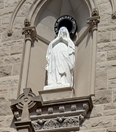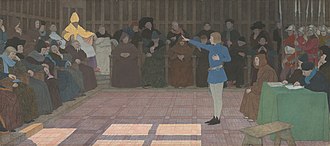Saint Joan of Arc (Jeanne la Pucelle): Difference between revisions
| Line 56: | Line 56: | ||
=== The Trials of Jeanne d'Arc === | === The Trials of Jeanne d'Arc === | ||
> see [https://www.jeanne-darc.info/trials-index/ Trials - Overview | Joan of Arc | Jeanne-darc.info] | > see [https://www.jeanne-darc.info/trials-index/ Trials - Overview | Joan of Arc | Jeanne-darc.info] | ||
== See also == | == See also == | ||
Revision as of 19:54, 3 February 2025
<<to move Translation: she's a witch!
Christology of Saint Joan
- born in poverty, among shepherds
- distrust of the leaders
- triumphant entry to Orleans
- betrayal
- Charles VII washing his hands of her
- championed by her mother
The prophecies of Joan of Arc
Jean Dunois testified that not all of Joan's prophesies were fulfilled[1],
Although Jeanne sometimes spoke in jest of the affairs of war, and although, to encourage the soldiers, she may have foretold events which were not realized, nevertheless, when she spoke seriously of the war, and of her deeds and her mission, she only affirmed earnestly that she was sent to raise the siege of Orleans, and to succour the oppressed people of that town and the neighbouring places, and to conduct the King to Rheims that he might be consecrated (emphasis added)
Prophecies of the coming of Saint Joan
- Merlin
- St. Bede
- Marie d'Avignon
Joan's own testimony on those prophesies
Joan told her Uncle , Durand Laxart, and a woman with whom she stayed on her second visit with him to Vaucouleurs,
“Was it not said that France would be ruined through a woman and afterwards restored by a virgin?”.
>> see Prophecies | Joan of Arc | Jeanne-darc.info
Why Joan only now?
Jeanne d'Arc was canonized in 1905. It's not unusual for such a long delay in beatification, but there are reasons for it with Saint Joan. So why so long for her?
Once her work was done, she was easily forgotten, beginning with the Siege of Orleans and the coronation of Charles VII, upon which the French court did its best to ignore her. Given the opportunity to ransom her upon her capture, the King refused and, well, washed his hands of her. Once they had consolidated rule over France, the kings had every reason -- well, aside from honesty -- not to attribute the legitimacy of their rule to a peasant girl.
>
A rather interesting document is found from a publication, "The Rationalist" from 1913, The Story of Joan of Arc: the Witch Saint,"[2] which seems to have been in response to Pius X's beatification of Joan (final step towards canonization). The author contends that "modern thought" has led to her vindication and not the Catholic Church, which is just using her shrine and stories of miracle cures before it as a "new income." The author says his essay will save Catholicism from itself.
French Revolution
> anticlerical
>
Franco-Prussian War
Historical sources
The history of Joan of Arc is comparatively well-documented, even for the 1400s, a period that yields plenty of artifacts and primary sources. The facts of her life a clear and incontestable. In her day, she was the subject of various documented inquiries, an extended court trial, and subsequent inquiries that document witnesses and assessed evidence. We even know much about her mystical experiences -- or whatever they were, as she told the record about them.
The Trials of Jeanne d'Arc
> see Trials - Overview | Joan of Arc | Jeanne-darc.info
See also
Here for list of pages on this site related to Saint Joan of Arc
Painting series "Jeanne D'Arc" (1895) by Louis-Maurice Boutet de Monvel
In 1896, Louis-Maurice Boutet de Monvel illustrated a children's book of the life of Joan of Arc.[3] Through the early 1900s, he expanded several of the images into full paintings, a collection of which are held by the National Gallery of Art in Washington DC, called "La Vie de Jeanne d'Arc":
-
La Vision (Vision of the Archangel St. Michael)
-
Appeal to the Dauphin (The Dauphin had someone else sit on the throne and hid amidst the Court; Joan identified him immediately)
-
The Maid in Armor on Horseback (Now Commander of the French Armies, Joan marches the army to free Orleans from the English siege)
-
The Turmoil of Conflict (The Battle of Orleans, which is nearly lost after Joan is hit in the shoulder and neck by a bolt, but she returns to the field and leads the French to victory)
-
The Crowning at Rheims of the Dauphin (Joan's mission was to have the Dauphin properly crowned King by French custom and in the form of Charlemagne; the leadership thought it was unnecessary, but Joan understood that the people of France needed the ceremony at the traditional place for it at the Cathedral at Rheims)
-
The Trial of Joan of Arc (The King and his councilors betray Joan, leaving her to fight with a small army; she is captured by the French ally of the English. The French King refuses to pay a ransom for her, and she is tried in a French ecclesiastic court under English authority)
Here for more on Boutet de Monvel and his works.
References
- ↑ Murray, p. 241
- ↑ The Story of Joan Of Arc the Witch--saint, by M. M. Mangasarian
- ↑ Scan of English version (abbreviated from the original French publication) available here: Joan of Arc : Boutet de Monvel, Louis Maurice, 1850-1913 (Archive.org) Here for page images of the original: Louis-Maurice Boutet de Monvel






